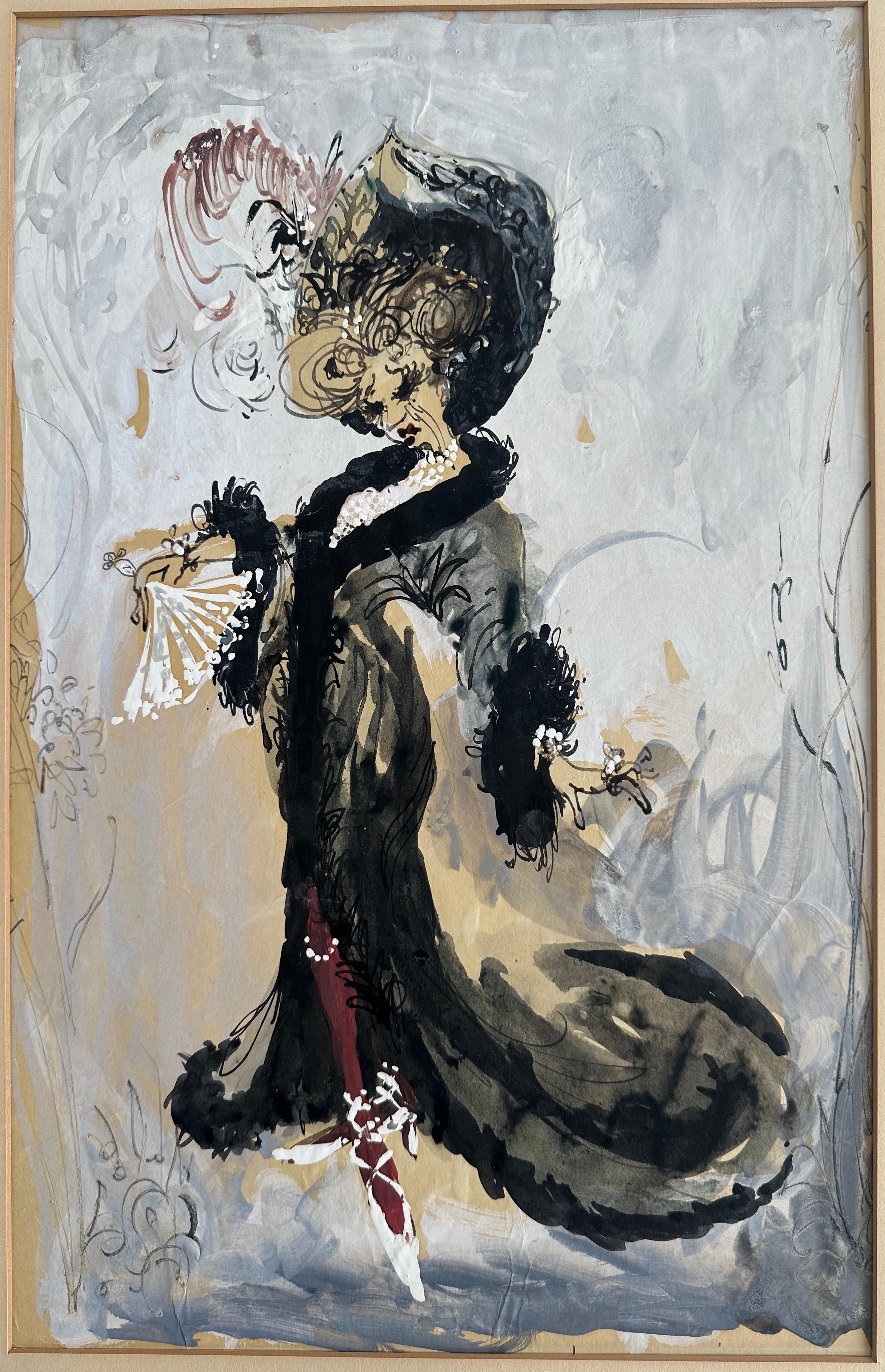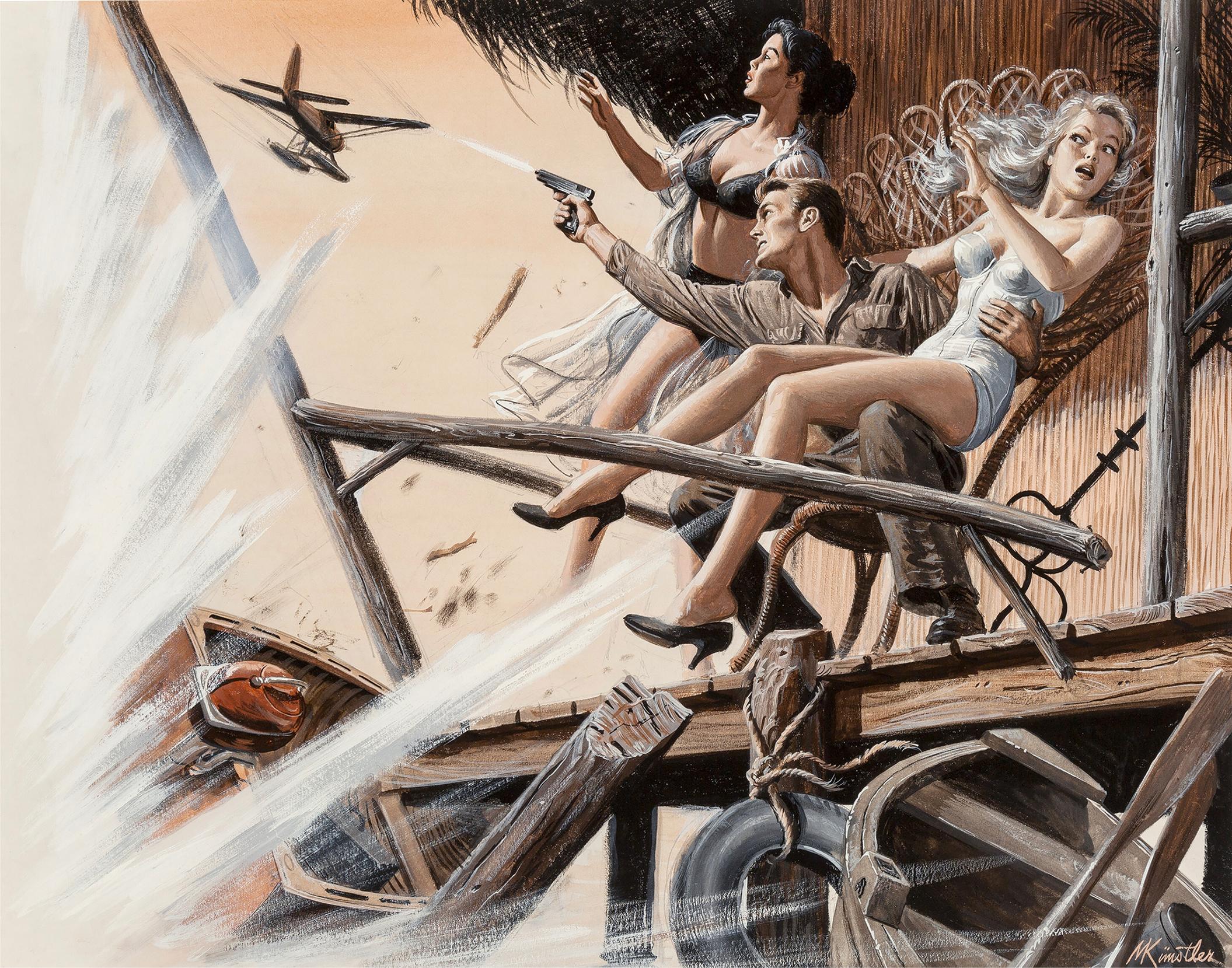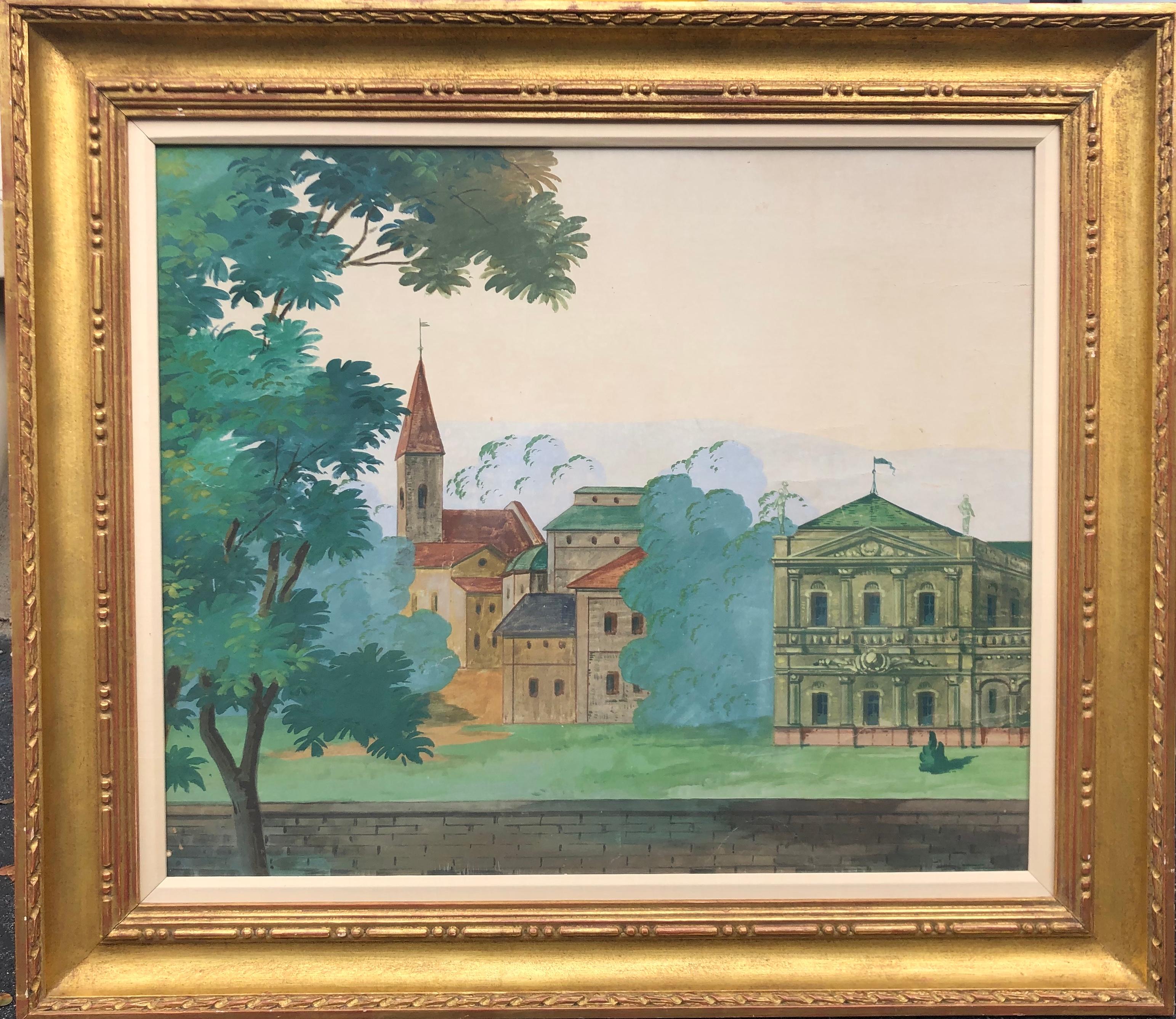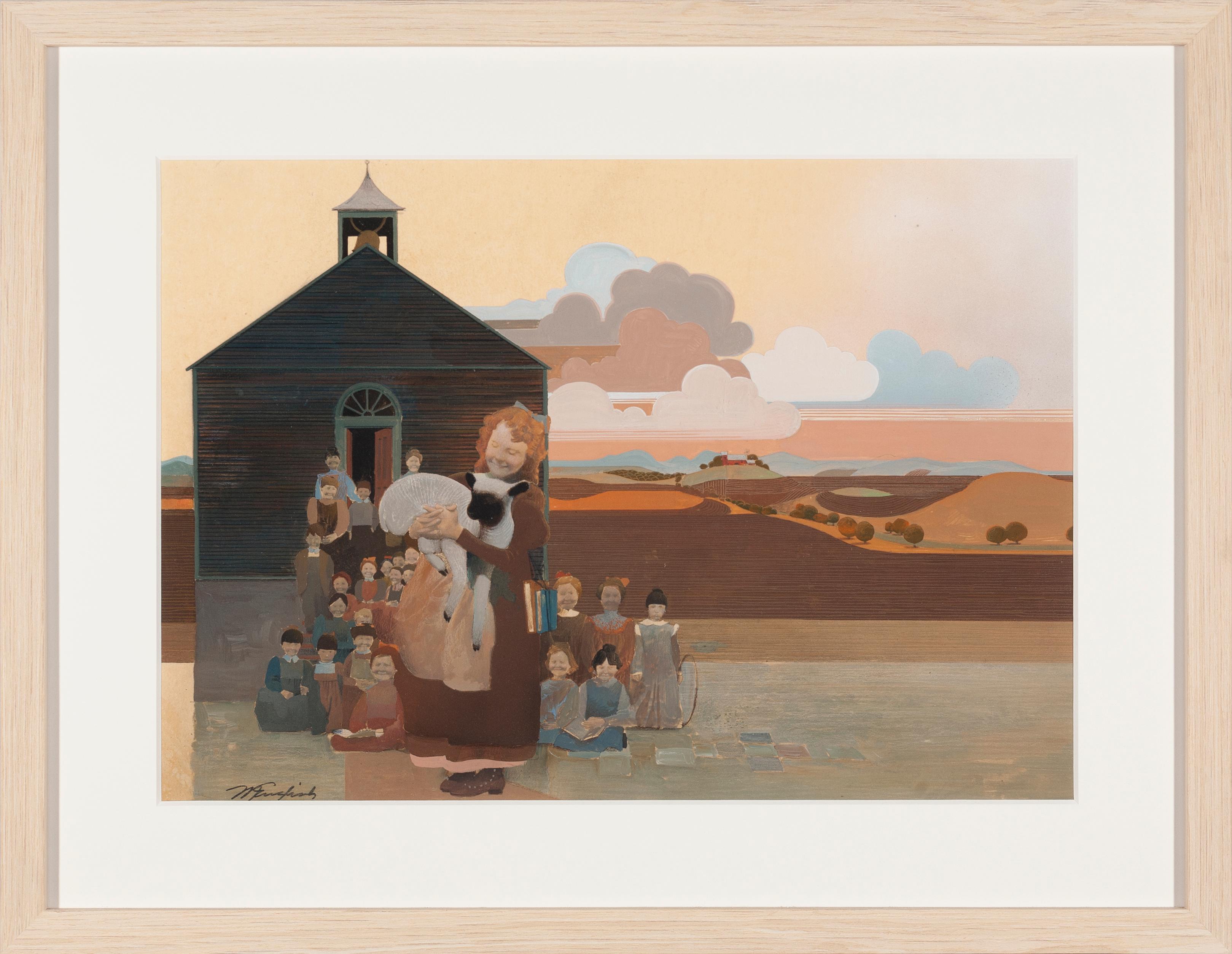Items Similar to Black Hamlet (Momento Mori) Cityscape
Want more images or videos?
Request additional images or videos from the seller
1 of 11
UnknownBlack Hamlet (Momento Mori) Cityscapeca. 2000
ca. 2000
About the Item
Beautiful painting depicts a young black man holding skull and flip phone. Gouache on illustration board, image measuring 8 x 10 inches; 16 x 20 inches framed. Signed lower left.
- Creation Year:ca. 2000
- Dimensions:Height: 20 in (50.8 cm)Width: 16 in (40.64 cm)Depth: 1 in (2.54 cm)
- Medium:
- Movement & Style:
- Period:
- Condition:
- Gallery Location:Wilton Manors, FL
- Reference Number:1stDibs: LU245214257402
About the Seller
4.9
Platinum Seller
These expertly vetted sellers are 1stDibs' most experienced sellers and are rated highest by our customers.
Established in 2007
1stDibs seller since 2015
329 sales on 1stDibs
Typical response time: 1 hour
- ShippingRetrieving quote...Ships From: Wilton Manors, FL
- Return PolicyA return for this item may be initiated within 7 days of delivery.
More From This SellerView All
- Broadway Costume Design IllustrationLocated in Wilton Manors, FLFabulous illustration depicts a costume for Broadway production. Gouache on illustration board, image measures 10.5 x 16.5 inches; 15 x 22 inches framed. Excellent condition in ori...Category
1960s Realist Figurative Paintings
MaterialsGouache, Illustration Board
- Art Deco Couple PortraitLocated in Wilton Manors, FLBeautiful Art Deco illustration by unknown artist. Ink and gouache on faux wood grain illustration board. Image field measuring 14 x 18 inches on a 17 x 21 inch illustration panel...Category
Early 20th Century Art Deco Figurative Paintings
MaterialsInk, Gouache, Illustration Board
- Same Old Story (Brooklyn Dodgers & St. Louis Cardinals Illustration)Located in Wilton Manors, FLBill Crawford (1913-1982). Original illustration artwork depicting teams as they advance to the World Series. Depicted are representations of the St. Louis Cardinals and The Brooklyn...Category
1940s Realist Figurative Paintings
MaterialsPaper, Charcoal, Ink, Gouache, Pencil
- Fancy Department Store Satirical CartoonLocated in Wilton Manors, FLBarbara Shermund (1899-1978). Fancy Department Store Satirical Cartoon, ca. 1930's. Ink, watercolor and gouache on heavy illustration paper, panel measures 19 x 15 inches. Signed lower right. Very good condition. Unframed. Provenance: Ethel Maud Mott Herman, artist (1883-1984), West Orange NJ. For two decades, she drew almost 600 cartoons for The New Yorker with female characters that commented on life with wit, intelligence and irony. In the mid-1920s, Harold Ross, the founder of a new magazine called The New Yorker, was looking for cartoonists who could create sardonic, highbrow illustrations accompanied by witty captions that would function as social critiques. He found that talent in Barbara Shermund. For about two decades, until the 1940s, Shermund helped Ross and his first art editor, Rea Irvin, realize their vision by contributing almost 600 cartoons and sassy captions with a fresh, feminist voice. Her cartoons commented on life with wit, intelligence and irony, using female characters who critiqued the patriarchy and celebrated speakeasies, cafes, spunky women and leisure. They spoke directly to flapper women of the era who defied convention with a new sense of political, social and economic independence. “Shermund’s women spoke their minds about sex, marriage and society; smoked cigarettes and drank; and poked fun at everything in an era when it was not common to see young women doing so,” Caitlin A. McGurk wrote in 2020 for the Art Students League. In one Shermund cartoon, published in The New Yorker in 1928, two forlorn women sit and chat on couches. “Yeah,” one says, “I guess the best thing to do is to just get married and forget about love.” “While for many, the idea of a New Yorker cartoon conjures a highbrow, dry non sequitur — often more alienating than familiar — Shermund’s cartoons are the antithesis,” wrote McGurk, who is an associate curator and assistant professor at Ohio State University’s Billy Ireland Cartoon Library & Museum. “They are about human nature, relationships, youth and age.” (McGurk is writing a book about Shermund. And yet by the 1940s and ’50s, as America’s postwar focus shifted to domestic life, Shermund’s feminist voice and cool critique of society fell out of vogue. Her last cartoon appeared in The New Yorker in 1944, and much of her life and career after that remains unclear. No major newspaper wrote about her death in 1978 — The New York Times was on strike then, along with The Daily News and The New York Post — and her ashes sat in a New Jersey funeral home...Category
1930s Realist Figurative Paintings
MaterialsInk, Gouache
- Life Magazine Satirical Society Cartoon IllustrationLocated in Wilton Manors, FLBarbara Shermund (1899-1978). Society Satirical Cartoon, ca. 1940s. Gouache on heavy illustration paper, image measures 17 x 14 inches; 23 x 20 inches in matting. Signed lower left. Very good condition but matting panel should be replaced. Unframed. Provenance: Ethel Maud Mott Herman, artist (1883-1984), West Orange NJ. For two decades, she drew almost 600 cartoons for The New Yorker with female characters that commented on life with wit, intelligence and irony. In the mid-1920s, Harold Ross, the founder of a new magazine called The New Yorker, was looking for cartoonists who could create sardonic, highbrow illustrations accompanied by witty captions that would function as social critiques. He found that talent in Barbara Shermund. For about two decades, until the 1940s, Shermund helped Ross and his first art editor, Rea Irvin, realize their vision by contributing almost 600 cartoons and sassy captions with a fresh, feminist voice. Her cartoons commented on life with wit, intelligence and irony, using female characters who critiqued the patriarchy and celebrated speakeasies, cafes, spunky women and leisure. They spoke directly to flapper women of the era who defied convention with a new sense of political, social and economic independence. “Shermund’s women spoke their minds about sex, marriage and society; smoked cigarettes and drank; and poked fun at everything in an era when it was not common to see young women doing so,” Caitlin A. McGurk wrote in 2020 for the Art Students League. In one Shermund cartoon, published in The New Yorker in 1928, two forlorn women sit and chat on couches. “Yeah,” one says, “I guess the best thing to do is to just get married and forget about love.” “While for many, the idea of a New Yorker cartoon conjures a highbrow, dry non sequitur — often more alienating than familiar — Shermund’s cartoons are the antithesis,” wrote McGurk, who is an associate curator and assistant professor at Ohio State University’s Billy Ireland Cartoon Library & Museum. “They are about human nature, relationships, youth and age.” (McGurk is writing a book about Shermund. And yet by the 1940s and ’50s, as America’s postwar focus shifted to domestic life, Shermund’s feminist voice and cool critique of society fell out of vogue. Her last cartoon appeared in The New Yorker in 1944, and much of her life and career after that remains unclear. No major newspaper wrote about her death in 1978 — The New York Times was on strike then, along with The Daily News and The New York Post — and her ashes sat in a New Jersey funeral...Category
1940s Realist Figurative Paintings
MaterialsGouache
- Sailors at Cafe du GlobeBy Charles RocherLocated in Wilton Manors, FLCharles Rocher (1890-1962. Sailors, ca. 1920s. Gouache on paper. Sheet measures 19 x 25 inches. Considerable damage and loss as depicted. Signed lower left.Category
1920s Realist Figurative Paintings
MaterialsGouache
You May Also Like
- Antique Illustration of a Golfer by Listed Illustrator for Vanity FairLocated in Buffalo, NYAntique illustration of a golfer getting out of a sand trap by well listed illustrator Leslie Saalburg whose work appeared in Vanity Fair and Esquire.Category
1910s Realist Figurative Paintings
MaterialsGouache, Illustration Board
- Soldier Shooting Gun with Bikini Girls, Mid-Century Mens Magazine WarBy Mort KünstlerLocated in Miami, FLThe artist tells a whole action-packed story in one picture. A handsome young soldier shoots his pistol at a passing bomb-dropping airplane. The close call splashes water on him and his two sexy girl...Category
1960s Realist Figurative Paintings
MaterialsBoard, Gouache, Pencil
- Summer Fashion. Young Victorian Lady With Meadow Flowers In Her Straw HatLocated in Sutton Poyntz, DorsetAlice Anne Renshaw. English ( b.1849 - d.1900 ). Young Lady With Meadow Flowers In Her Straw Hat Watercolor & Gouache on Artist's Board ( An embossed stamp in the top left hand corner reads 'Turnbull’s Superfine London Board' ) . Signed. Image size 21.3 inches x 16.7 inches ( 54cm x 42.5cm ). Frame size 29.9 inches x 25.6 inches ( 76cm x 65cm ). Available for sale; this original painting is by Alice Anne Renshaw and dates from around 1880. The painting is presented and supplied in its original highly ornate...Category
Late 19th Century Realist Figurative Paintings
MaterialsWatercolor, Gouache, Board
- View Of The CityLocated in Lake Worth Beach, FLEarly 20th Century European School, view of the city, with buildings in the background, gouache on paper unsigned in a beautiful custom made Haydenryk frame under glass.Category
Early 20th Century Realist Landscape Paintings
MaterialsGouache, Board
- Mary Had a Little LambLocated in Columbia, MOOne of the most prolific and acclaimed illustrators of the 20th century, Mark English produced work for such publications as McCalls, Time, Sports Illustrated, and Redbook before co-...Category
1980s Contemporary Landscape Paintings
MaterialsPastel, Gouache, Illustration Board
- Late 19th Century Original English Landscape of a Cottage in CambriaLocated in Soquel, CALate 19th Century Original English Landscape of a Cottage in Cambria Wonderful original antique painting of a thatched cottage in Cambria by...Category
1880s Impressionist Figurative Paintings
MaterialsGouache, Illustration Board



